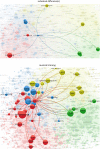The Musical Abilities, Pleiotropy, Language, and Environment (MAPLE) Framework for Understanding Musicality-Language Links Across the Lifespan
- PMID: 36742012
- PMCID: PMC9893227
- DOI: 10.1162/nol_a_00079
The Musical Abilities, Pleiotropy, Language, and Environment (MAPLE) Framework for Understanding Musicality-Language Links Across the Lifespan
Abstract
Using individual differences approaches, a growing body of literature finds positive associations between musicality and language-related abilities, complementing prior findings of links between musical training and language skills. Despite these associations, musicality has been often overlooked in mainstream models of individual differences in language acquisition and development. To better understand the biological basis of these individual differences, we propose the Musical Abilities, Pleiotropy, Language, and Environment (MAPLE) framework. This novel integrative framework posits that musical and language-related abilities likely share some common genetic architecture (i.e., genetic pleiotropy) in addition to some degree of overlapping neural endophenotypes, and genetic influences on musically and linguistically enriched environments. Drawing upon recent advances in genomic methodologies for unraveling pleiotropy, we outline testable predictions for future research on language development and how its underlying neurobiological substrates may be supported by genetic pleiotropy with musicality. In support of the MAPLE framework, we review and discuss findings from over seventy behavioral and neural studies, highlighting that musicality is robustly associated with individual differences in a range of speech-language skills required for communication and development. These include speech perception-in-noise, prosodic perception, morphosyntactic skills, phonological skills, reading skills, and aspects of second/foreign language learning. Overall, the current work provides a clear agenda and framework for studying musicality-language links using individual differences approaches, with an emphasis on leveraging advances in the genomics of complex musicality and language traits.
Keywords: complex trait genetics; individual differences; musicality; neural endophenotypes; pleiotropy; speech and language development.
© 2022 Massachusetts Institute of Technology.
Conflict of interest statement
Competing Interests: The authors have declared that no competing interests exist.
Figures





Similar articles
-
Intergenerational longitudinal associations between parental reading/musical traits, infants' auditory processing, and later phonological awareness skills.Front Neurosci. 2023 Jul 19;17:1201997. doi: 10.3389/fnins.2023.1201997. eCollection 2023. Front Neurosci. 2023. PMID: 37539387 Free PMC article.
-
Links of Prosodic Stress Perception and Musical Activities to Language Skills of Children With Cochlear Implants and Normal Hearing.Ear Hear. 2020 Mar/Apr;41(2):395-410. doi: 10.1097/AUD.0000000000000763. Ear Hear. 2020. PMID: 31397704
-
What Makes Babies Musical? Conceptions of Musicality in Infants and Toddlers.Front Psychol. 2021 Dec 15;12:736833. doi: 10.3389/fpsyg.2021.736833. eCollection 2021. Front Psychol. 2021. PMID: 35095640 Free PMC article.
-
Defining the biological bases of individual differences in musicality.Philos Trans R Soc Lond B Biol Sci. 2015 Mar 19;370(1664):20140092. doi: 10.1098/rstb.2014.0092. Philos Trans R Soc Lond B Biol Sci. 2015. PMID: 25646515 Free PMC article. Review.
-
Music training for the development of reading skills.Prog Brain Res. 2013;207:209-41. doi: 10.1016/B978-0-444-63327-9.00008-4. Prog Brain Res. 2013. PMID: 24309256 Review.
Cited by
-
Preschool musicality is associated with school-age communication abilities through genes related to rhythmicity.NPJ Sci Learn. 2025 Jun 13;10(1):39. doi: 10.1038/s41539-025-00329-y. NPJ Sci Learn. 2025. PMID: 40514356 Free PMC article.
-
Musicality as a Health-Relevant Factor for Hearing Outcomes.JAMA Otolaryngol Head Neck Surg. 2025 Feb 1;151(2):95-96. doi: 10.1001/jamaoto.2024.4157. JAMA Otolaryngol Head Neck Surg. 2025. PMID: 39636621 Free PMC article.
-
Exploring the genetics of rhythmic perception and musical engagement in the Vanderbilt Online Musicality Study.Ann N Y Acad Sci. 2023 Mar;1521(1):140-154. doi: 10.1111/nyas.14964. Epub 2023 Jan 30. Ann N Y Acad Sci. 2023. PMID: 36718543 Free PMC article.
-
Topical Cellular/Tissue and Molecular Aspects Regarding Nonpharmacological Interventions in Alzheimer's Disease-A Systematic Review.Int J Mol Sci. 2023 Nov 20;24(22):16533. doi: 10.3390/ijms242216533. Int J Mol Sci. 2023. PMID: 38003723 Free PMC article.
-
Musical Sophistication and Multilingualism: Effects on Arcuate Fasciculus Characteristics.Hum Brain Mapp. 2024 Oct;45(14):e70035. doi: 10.1002/hbm.70035. Hum Brain Mapp. 2024. PMID: 39360580 Free PMC article.
References
-
- Andreola, C., Mascheretti, S., Belotti, R., Ogliari, A., Marino, C., Battaglia, M., & Scaini, S. (2021). The heritability of reading and reading-related neurocognitive components: A multi-level meta-analysis. Neuroscience and Biobehavioral Reviews, 121, 175–200. 10.1016/j.neubiorev.2020.11.016, - DOI - PubMed
-
- Antoniou, M., To, C. K. S., & Wong, P. C. M. (2015). Auditory cues that drive language development are language specific: Evidence from Cantonese. Applied Psycholinguistics, 36(6), 1493–1507. 10.1017/S0142716414000514 - DOI
Publication types
Grants and funding
LinkOut - more resources
Full Text Sources
